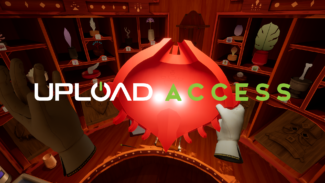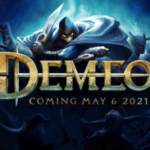For a game with such philosophical aspirations, Maskmaker’s inspirations are surprisingly literal.
For starters, one can feel the steady guiding hand of the Metroidvania genre in the game’s branching paths and come-back-later road bumps. Maskmaker lets you travel between worlds by putting on masks that match those worn by lifeless figures dotted throughout its biomes. Putting on a mask allows you to embody the character wearing a matching design. Having seen this mechanic in action, it’s definitely easier to trace Maskmaker’s design influences back through time than it is A Fisherman’s Tale. But, for Creative Director Balthazar Auxietre, there are two other more important touchstones.
Behind The Mask
“My father was a collector of traditional masks from all over the world,” Auxietre tells me. “But it was in his workshop. So when I was able to sneak into his workshop when he was painting or doing other stuff, I was quite astonished by all the different personalities of these masks.”
Fuel enough for a VR adventure that calls back to his childhood roots, but Auxietre’s other influence is even more direct – a 1975 mime performance from French actor Marcel Marceau named, believe it or not, The Maskmaker.
The short piece sees Marceau silently navigate his way through a range of expressions, each worn with striking exaggeration as he mimes appropriate actions for each emotion. As the piece develops, Marceau switches between emotions with remarkable pace before landing on a fixed, faintly terrifying smile he can’t seem to remove. Watching him try to fix it becomes increasingly uncomfortable and yet oddly identifiable.
“So the piece was super intriguing and mysterious because the actor plays with masks and changes faces,” Auxietre says. “And at some point he’s stuck with a mask on his face. The impossibility of taking off the mask and this feeling of being trapped inside a mask connected with the idea of playing with masks to explore the world.”
But it wasn’t just Marceau’s performance that stayed with Auxietre. The actor’s opening introduction also offers a key hint into the themes behind the upcoming game: “For me the Maskmaker is the man who represents humanity, who is all the faces humanity can possess.”
“It’s a sentence that I kept close to my heart during all the production because I think giving this power to someone is a pretty a pretty strong endeavour,” Auxietre says. “And even if it’s for a few hours in a game, I thought this could be quite amazing to play with this idea of embodying a lot of different characters, playing with the faces of humanity.”
Typically lofty concepts for developer Innerspace VR, then. But Maskmaker, Auxietre explains, takes these inspirations in a much more “concrete” way than you might be expecting.
His father’s work, for example, informs more of the game’s setting and crafting than it does the story. At any time in the game, you can head back to your own workshop to craft new masks with a variety of tools. It’s here where Auxietre’s childhood really takes center stage. “Even more than the masks, the atmosphere you had in the workshop was something pretty exciting for me,” he recalls. “Because it’s almost creepy when it it’s not completely lit. You have all the tools around. And, at the same time, it’s a place of opportunity because you can make anything and it’s a place also to lose yourself in because you close the door and you cannot the see the light of the day passing by.”
You’ll see more of that element in some of our Upload Access coverage to come but, for now, Auxietre teases why it made sense for the game: “It felt like a perfect place to tell a story and a perfect place, in VR, to make stuff.”
Masking Metroid
Building out those memories into a concept for a game didn’t actually come about until Auxietre became involved in VR, though. The mechanic of navigating worlds by putting on different masks was something the team even began to investigate with its last game, but ultimately set aside, deciding it needed more attention paid to it. Maskmaker was pitched to publisher MWM Interactive around the time A Fisherman’s Tale reached Quest.
In fact, the game is aiming to directly address some of the key criticisms levelled at A Fisherman’s Tale, namely that it wasn’t long enough. But the team also didn’t want to just deliver on length for the sake of it, which is why Innerspace built out larger environments with multiple paths to take.
“Metroidvania was really kind of a role model for us, even if we didn’t exactly follow the rules by the book,” the developer explains. “I think it’s an attempt of making a Metroidvania with masks, but it’s a pretty modest attempt. Because even if the game is much more open than A Fisherman’s Tale, it’s not as open like a Metroid game is.”
Don’t expect a big sprawling map that will have you getting lost around every corner, then, but Maskmaker does offer players some of their own agency in how to progress. For the team, building out a bigger game meant giving in to some of the concessions of current VR game design, like offering different locomotion styles — none of which feel particularly immersive — to navigate environments.
“We choose our battles,” Auxietre explains. “We knew that if the game was larger scope and we wanted to created environments the player could explore and we didn’t want to spend too much time reinventing the wheel of VR locomotion.”
And, while it may play to some conventions that its predecessor avoided, the developer stresses that this is in service of something completely unique to the platform: “Even if it’s a really different concept from A Fisherman’s Tale, which was really true to VR in a way, this is also something that feels really inherently VR experience,” Auxietre says. “And I think that the fact that you wear a mask from beginning to end and many masks is really a strong part of it.”
Exactly how Maskmaker juggles its inspirations, concepts and mechanics alongside its story (which we got a quick glimpse at least week) remains to be seen. Ultimately, Auxietre wants Maskmaker’s exploration of humanity’s many faces to help players find their own. He hopes that, at the end of the game when they take off the headset, “they feel even more themselves than before.”







